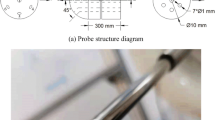Abstract
This paper discusses the use of a seven-hole probe on measurements of leading edge vortices of highly sweep delta wing planforms. Intrusive probe data taken with the pressure probe were compared with non-intrusive measurements made with laser Doppler anemometry system. In addition to probe size, the natural position of breakdown and the sweep angle of the wing are also factors in determining sensitivity of the flow to probe interference. At low angles of attack vortex breakdown does not occur in the vincinity of the model and the seven hole probe was found to yield reasonably accurate measurements. When the angle of attack of the model was increased so that vortex breakdown was near the trailing edge, introducing the probe over the wing would cause the breakdown position to move ahead of the probe. However, when breakdown naturally occurred ahead of the mid-chord of the wing the vortices were found to be less sensitive to a probe placed behind the breakdown point. Vortex breakdown on a lower swept wing is found to be more sensitive to interference. Near the breakdown region, seven hole probe measurement is less accurate due to a combination of probe interference and flow reversal.
Similar content being viewed by others
References
Anders, K. 1982: LDV measurements of the velocity field of a leading edge vortex over a delta wing before and after vortex breakdown. VKI Bruxelles, Tech. note 142
Anderson, M. W.; Beran, P. S.; McCann, M. K. 1983: Vortex break-down over delta wings. Grad. Aero. Lab., California Inst. Technol. Pasadena/CA, USA
Chigier, N. A. 1974: Measurement of vortex breakdown over a delta wing using a laser anemometer. Nielson Engineering, NEAR TR 62
Earnshaw, P. B. 1961: An experimental investigation of the structure of a leading-edge vortex. R.A.E. Tech. note no. Aero. 2740
Gerner, A. A.; Maurer, C. L.; Gallington, R. W. 1984: Non-nulling seven-hole probes for high angle flow measurement. Exp. Fluids 2, 95–103
Hummel, D. 1965: Untersuchungen über das Aufplatzen der Wirbel an schlanken Deltaflügeln. Z. Flugwiss. 13, 158–168
Hummel, D. 1978: On the vortex formation over a slender wing at large angles of incidence. AGARD-CP-247
Payne, F. M. 1987: The structure of leading edge vortex flows including vortex breakdown. Ph.D. Diss., Dept. of Aerospace and Mechanical Engineering, University of Notre Dame, Notre Dame/IN, USA
Payne, F. M.; Ng, T. T.; Nelson, R. C. 1987: Experimental study of the velocity field on a delta wing. AIAA pap. 87-1231
Sforza, P. M.; Smorto, M. J. 1980: Streamwise development of the flow over a delta wing. AIAA pap. 80-0200
Sforza, P. M.; Stasi, W.; Pazienza, J.; Smorto, M. 1977: Flow measurements in leading edge vortices. AIAA pap. 77-11
Verhaagen, N. G.; Kruisbrink, A. C. 1985: The entrainment effect of a leading edge vortex. AIAA pap. 85-1584
Vorropoulos, G.; Wendt, J. F. 1982: Preliminary results of LDV surveys in the compressible leading edge vortex of a delta wing. VKI Bruxelles, Tech. note 137
Wentz, W. H.; Kohlman, D. L. 1971: Vortex breakdown on slender sharp-edged wings, J. Aircraft 8, 156–161
Author information
Authors and Affiliations
Rights and permissions
About this article
Cite this article
Payne, F.M., Ng, T.T. & Nelson, R.C. Seven hole probe measurement of leading edge vortex flows. Experiments in Fluids 7, 1–8 (1989). https://doi.org/10.1007/BF00226590
Received:
Issue Date:
DOI: https://doi.org/10.1007/BF00226590




